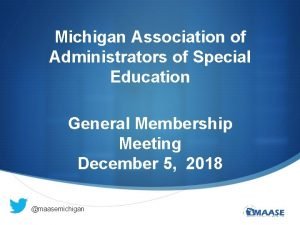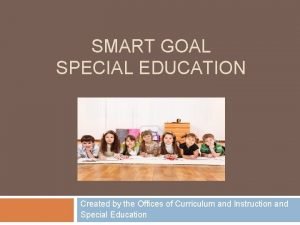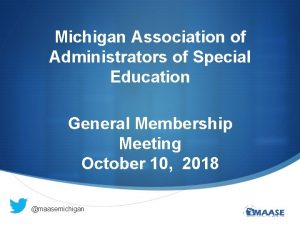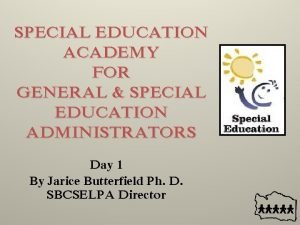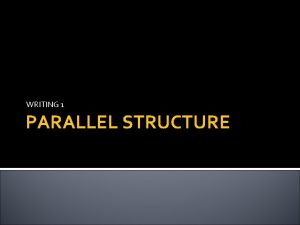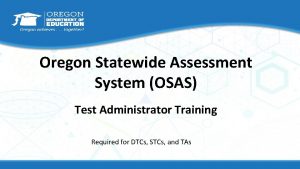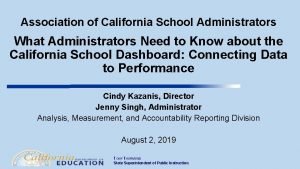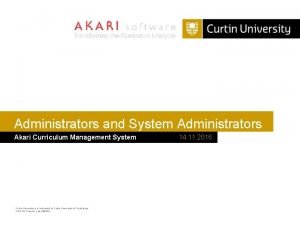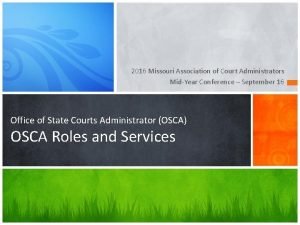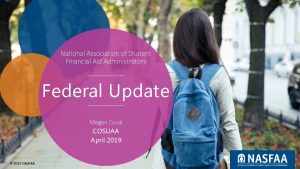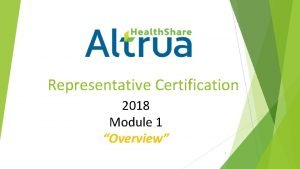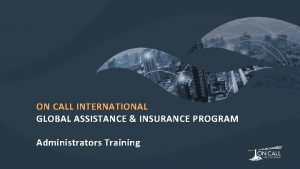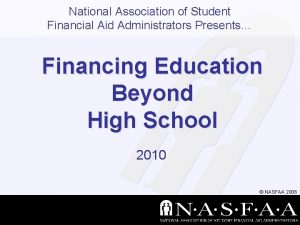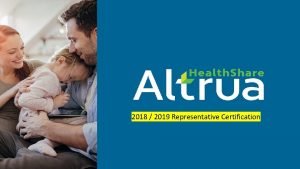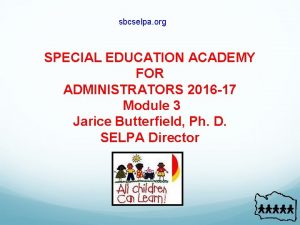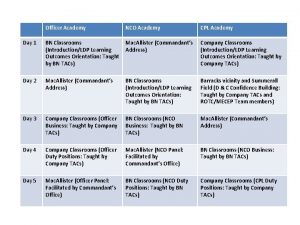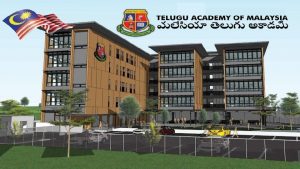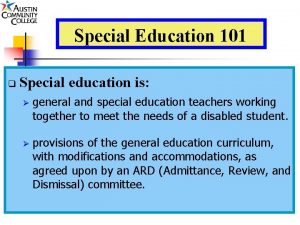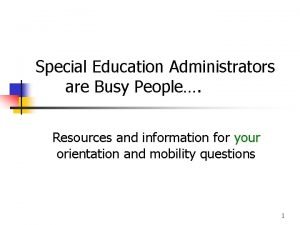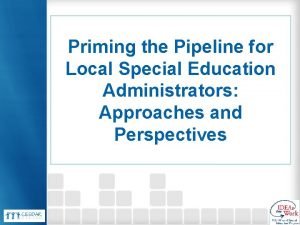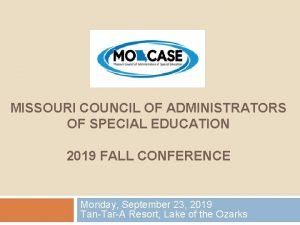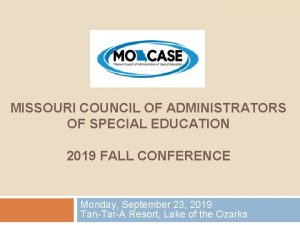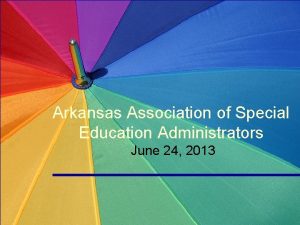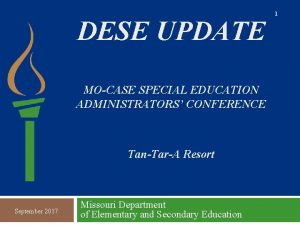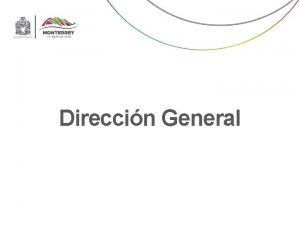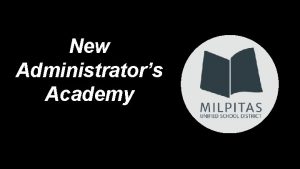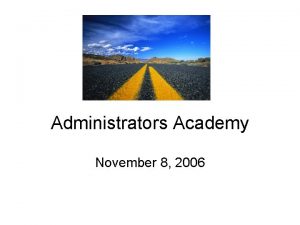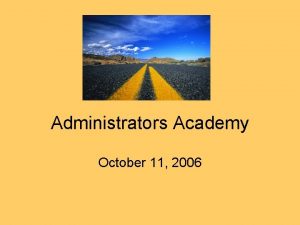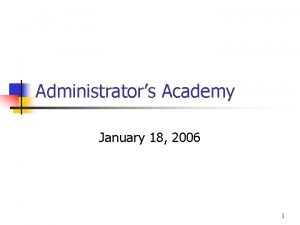SPECIAL EDUCATION ACADEMY FOR GENERAL SPECIAL EDUCATION ADMINISTRATORS












































- Slides: 44

SPECIAL EDUCATION ACADEMY FOR GENERAL & SPECIAL EDUCATION ADMINISTRATORS Day 1 By Jarice Butterfield Ph. D. SBCSELPA Director

Agenda Ø Overview of SELPA – Jarice Butterfield Ø IDEA; 13 Eligibility categories for SPED; LRE Ø Continuum of Program Options / Regional Programs Ø Non Public Agencies and Schools (NPA) and (NPS) 2

Overview of SBCSELPA provides oversight, guidance, training and support to member local education agencies (LEAs), parents, guardians, and the community related to identifying and providing compliant, best practice Individualized Education Plan (IEP) services to students with disabilities. sbcselpa. org 3

What is a SELPAs ensure that students with disabilities have a access to a free appropriate public education (FAPE)…. ØIn the least restrictive environment (LRE) ØAs described in the IEP designed to provide “educational benefit” 4

What Does SBCSELPA Do? Santa Barbara County Special Education Local Plan Area (SBCSELPA), is a Joint Powers Agency that… 5

What Does SBCSELPA Do? 1) Oversees and facilitates the implementation of special education programs administered by the Local Education Agencies (LEAs) or school districts within Santa Barbara County… 6

What Does SBCSELPA Do? 2) Develops policies and procedures for special education programs throughout Santa Barbara County… 7

What Does SBCSELPA Do? 3) Provides guidance regarding federal & state special education laws and regulations to all stakeholders (LEAs/school districts, parents, & community members) 8

What Does SBCSELPA Do? 4) Allocates state and federal funding to all 22 LEAs/school districts in Santa Barbara County, based on the Board approved funding model, to provide special education services to students with disabilities 9

What Does SBCSELPA Do? 5) Coordinates and provides training/professional development to school district staff, community members, and parents to further their knowledge in the area of Special Education… 10

What Does SBCSELPA Do? 6) Facilitates “job-alike” networking meetings for special education professionals… 11

What Does SBCSELPA Do? 7) Oversees the placement & services of students whose education needs cannot be met within the continuum of program options available within SBCSELPA who are placed by IEP teams in Non Public Schools (NPS) residential treatment centers (RTC) 12

What Does SBCSELPA Do? 8) Initiates Master Contracts for NPA on behalf of LEA/School Districts Ø Any contractor providing IEP services must have NPA licensure through the California Department of Education (CDE) Ø NPA providers may only provide IEP related services Ø LEA/School Districts must do an Individual Service Agreement (ISA) for all contract services 13

What Does SBCSELPA Do? 9) Maintains a website containing the Local Plan, JPA Board agendas, and other resources for parents, teachers, and administrators. 14

What Does SBCSELPA Do? 10) Provides Training and Support in the ADR Process; Engages in Alternative Dispute Resolution (ADR) for LEAs/Districts and Parent/guardians Ø LEAs/Districts administrators or IEP chairs have been trained in IEP collaboration and Facilitated IEPS Ø A SBCSELPA team of ADR Specialists is available to assist LEAs/District resolve disputes at the local level in order to ensure students get FAPE and avoid due process 15

Types/Levels of ADR Services available from SBCSELPA Level I ADR Ø All LEA site leaders (that oversee IEPs) & SPED Administrators have been trained in ADR Best Practices by an outside, nationally-known consultant (TBD) one full day Ø Two-three follow-up round table meetings took place after SEAM to do group work and follow-up coaching with the SELPA ADR Team (for special education administrators and other site administrators from LEAs) 16

Types/Levels of ADR Services available from SBCSELPA Level II ADR Ø The SBCSELPA has a designated, fully trained Facilitated IEP and ADR Mediation team Ø SBCSELPA funded a mediator certification for all designated ADR CADRE team members Ø SBCSELPA provided a comprehensive training in facilitated IEP training to the designated SELPA ADR team and special education administrators (optional) 17 17

Types/Levels of ADR Services available from SBCSELPA Level III ADR Ø SELPA Director is available to LEAs/districts to conduct due process filing resolution sessions (non attorney involved resolution sessions) and help guide the process Ø SELPA Director is available to LEAS/districts and parent/guardians to conduct ADR meetings as requested by either party 18

When to Request a Facilitated IEP or ADR Meeting Ø IEP is not Consented to – LEA/District team has made one or more attempt to resolve an offer of FAPE IEP dispute with a family; LEA may call an ADR meeting prior to filing for due process Ø Parent/guardian threatens to or files a complaint with the LEA/District or SBCSELPA Ø Parent/guardian files a complaint with the California Department of Education (CDE) 19

Individual with Disabilities Education Act (IDEA) 20

Individuals with Disabilities Education Act “IDEA” Students with disabilities have a right to a free appropriate public education (FAPE)…. ØIn the least restrictive environment (LRE) ØAs described in the IEP designed to provide “educational benefit” 21

13 Categories of Eligibility for Special Education Under IDEA 1) 2) 3) 4) 5) 6) 7) 22 Autism Deaf-Blindness Deafness Emotional Disturbance Hearing Impairment Intellectual Disability Multiple Disabilities 8) Orthopedic Impairment 9) Other Health Impairment 10) Specific Learning Disability 11) Speech or Language Impairment 12) Traumatic Brain Injury 13) Visual Impairment – including blindness 22

Designed to provide “Educational Benefit” 23

Guiding Principles of IDEA Ø High Expectations and Accountability Ø Improving Results through the General Curriculum Ø Education with Typically Developing Peers Ø Parental Involvement and Partnerships Ø Increased Efficiency and Flexibility 24

Parent Involvement Ø Strengthening the role and responsibility of parents Ø Ensuring that families have meaningful opportunities to participate in the education of their children at school and at home; 25

LANDMARK FAPE CASES Rowley Versus Endrew F. Case 26

Rowley Decision In 1982 in the Board of Education of the Hendrick Hudson Central School District v. Rowley, 458 U. S. 176 (1982), the U. S. Supreme Court addressed the level of instruction and services necessary to provide FAPE. This case set a precedence and is referred to as the ROWLEY STANDARD of FAPE 27

Rowley Decision (Continued) U. S. Supreme Court concluded that the IDEA does not require that States maximize the potential of students with disabilities. 28

Rowley Decision (Continued) Under the “Rowley Standard” An Appropriate IEP Is One That: ØIs calculated to provide educational benefit, according to the student’s individual needs as assessed at the time the offer of FAPE is made ØIs likely to produce more than trivial educational advancement 29

2016 Endrew F. Case Ø In Endrew F. the Supreme Court ruled that districts must go the extra mile to accommodate students with disabilities Ø Endrew F. ’s was a student with autism whose parents felt public school had failed him. They sought reimbursement for a private school placement. Ø The higher standard of FAPE was endorsed by the Obama Administration and Democratic members of Congress. Great concern that this will result in much higher costs without adequate funding Ø 30

2016 Endrew F. Case Continued Ø Chief Justice John Roberts wrote for the court that a “child’s education program must be appropriately ambitious in light of his circumstances, just as advancement from grade to grade is appropriately ambitious for most children in the regular classroom. ” 31

What Is Least Restrictive Environment “LRE”? ØTo the maximum extent appropriate, children with disabilities…are educated with children who are not disabled ØSpecial classes, separate schooling, or other removal…from the regular educational environment occurs only if the nature or severity of the disability is such that education in regular classes with the use of supplementary aids and services cannot be achieved satisfactorily 34 CFR Section 300. 114 32

Education with Typically Developing Peers Least Restrictive Environment (LRE) Ø Research supports the instruction of students with disabilities in general education with typically developing peers Ø Service in general education means needed supports and modifications 33

Annual Performance Report (APR) Indicator #5 LRE Districts are rated annually on LRE and receive sanctions if the LRE indicators are not met 34

APR Report Activity • Go to CDE Website http: //www. cde. ca. gov/ Specialized Programs Special Education - Data Collection & Reporting Annual Report Measures (scroll to bottom) http: //www. cde. ca. gov/sp/se/ds/leadatarpts. asp Select the letter corresponding to your district 1. Are there any indicators not met? 35

Leadership Strategies to Promote Inclusion Creating a Culture of Inclusion: Ø Review incident reports or APR report to determine whether students with disabilities are disproportionately represented in SPED Ø Celebrate inclusion daily and during Inclusive schools week Dec. 2 -6 Ø Invite parents of students with disabilities in to discuss what’s working and what’s not The Special Educator Vo. 29 Issue 5 2013 LRP 36

CONTINUUM OF SPECIAL EDUCATION PLACEMENT OPTIONS 37

Continuum of Placement Options Least Restrictive General Education 100% of the school day General Education the majority of the school day with some pull out time Pull out into a special education environment the majority of the school day (special class) on comprehensive school campus Pull out into a special education classroom not on a comprehensive school campus Non public School Placement with residential treatment 38 38 Home instruction

NON PUBLIC SCHOOL PLACEMENTS (NPS) 39

Non Public Schools (NPS) Ø Are private schools that provide educational programs to students with IEPS – may be 1) day treatment program only, or 2) day treatment with residential component (NPS RTC) Ø Santa Barbara County has NO NPS – so students must go to RTC if they need a NPS Ø Students are placed in a NPS if the district is unable to provide FAPE due to no continuum of program options available to serve the student 40

Non Public Schools (NPS) Cont’d Ø Must seek NPS Certification through the California Department of Education (CDE) Ø NPS must have a MASTER CONTRACT with SELPA Ø An Individual Services Agreement (ISA) must be drafted and maintained for each student served by in a NPS Ø Are costly $175, 000 - $350, 000 per year per student Ø In SBCSELPA the SELPA funds the NPS placement if a referral is made by the district that meets the Local Plan criteria 41

NON PUBLIC AGENCY (NPA) RELATED SERVICES 42

What is a NPA and When are They Utilized Ø Are private agencies that provide IEP “RELATED SERVICES” Ø Must have a MASTER CONTRACT with SELPA Ø Must seek NPA Certification through the California Department of Education (CDE) Ø An Individual Services Agreement (ISA) must be drafted and maintained for each student served by a NPA Ø Are costly and used when the district is not able to provide a “related service” in a IEP Ø NPA must have the appropriate required CDE licensure to provide the related service or services 43

QUESTIONS & ANSWERS 44
 Michigan association of special education administrators
Michigan association of special education administrators Smart goals for special education administrators
Smart goals for special education administrators Michigan association of special education administrators
Michigan association of special education administrators First nations education administrators association
First nations education administrators association Sbcselpa
Sbcselpa I consider your behavior rude irresponsible and offensive
I consider your behavior rude irresponsible and offensive Osas tam
Osas tam Iste standards for administrators
Iste standards for administrators Hbcu title iii administrators
Hbcu title iii administrators California association of school administrators
California association of school administrators He was treated like a ____ and cast out from his community.
He was treated like a ____ and cast out from his community. Crown healthshare administrators
Crown healthshare administrators Akari dashboard
Akari dashboard Missouri association of court administrators
Missouri association of court administrators Dilignece
Dilignece Black public administrators
Black public administrators National association of financial aid administrators
National association of financial aid administrators Crown healthshare administrators inc
Crown healthshare administrators inc International global assistance
International global assistance National association of financial aid administrators
National association of financial aid administrators Crown healthshare administrators inc
Crown healthshare administrators inc Fspos
Fspos Novell typiska drag
Novell typiska drag Tack för att ni lyssnade bild
Tack för att ni lyssnade bild Ekologiskt fotavtryck
Ekologiskt fotavtryck Varför kallas perioden 1918-1939 för mellankrigstiden?
Varför kallas perioden 1918-1939 för mellankrigstiden? En lathund för arbete med kontinuitetshantering
En lathund för arbete med kontinuitetshantering Personalliggare bygg undantag
Personalliggare bygg undantag Personlig tidbok för yrkesförare
Personlig tidbok för yrkesförare Sura för anatom
Sura för anatom Densitet vatten
Densitet vatten Datorkunskap för nybörjare
Datorkunskap för nybörjare Tack för att ni lyssnade bild
Tack för att ni lyssnade bild Mall för debattartikel
Mall för debattartikel Delegerande ledarstil
Delegerande ledarstil Nyckelkompetenser för livslångt lärande
Nyckelkompetenser för livslångt lärande Påbyggnader för flakfordon
Påbyggnader för flakfordon Arkimedes princip formel
Arkimedes princip formel Svenskt ramverk för digital samverkan
Svenskt ramverk för digital samverkan Urban torhamn
Urban torhamn Presentera för publik crossboss
Presentera för publik crossboss Argument för teckenspråk som minoritetsspråk
Argument för teckenspråk som minoritetsspråk Plats för toran ark
Plats för toran ark Treserva lathund
Treserva lathund Epiteltyper
Epiteltyper
